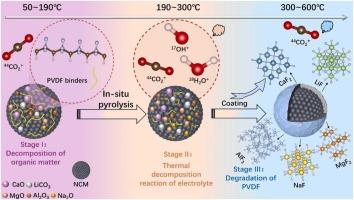当前位置:
X-MOL 学术
›
J. Hazard. Mater.
›
论文详情
Our official English website, www.x-mol.net, welcomes your
feedback! (Note: you will need to create a separate account there.)
Pollutant-free pyrolysis strategy for direct upgrading of cathode materials from spent lithium-ion batteries
Journal of Hazardous Materials ( IF 12.2 ) Pub Date : 2024-11-17 , DOI: 10.1016/j.jhazmat.2024.136553 Pengwei Li, Shaohua Luo, Guodong Hao, Kuo Sun, Qiuyue Liu, Martin Møller, Deyong Wang, Peter Kjær Kristensen, Leonid Gurevich, Lars Rosgaard Jensen, Li Wang, Xiangming He
Journal of Hazardous Materials ( IF 12.2 ) Pub Date : 2024-11-17 , DOI: 10.1016/j.jhazmat.2024.136553 Pengwei Li, Shaohua Luo, Guodong Hao, Kuo Sun, Qiuyue Liu, Martin Møller, Deyong Wang, Peter Kjær Kristensen, Leonid Gurevich, Lars Rosgaard Jensen, Li Wang, Xiangming He

|
The recycling of lithium-ion batteries (LIBs) has been dogged by air pollutants containing fluoride (e.g. HF, PF5, POF3). Pyrolysis is a technique that can eliminate polyvinylidene fluoride (PVDF) from the cathode electrode sheets of spent LIBs, effectively separating the cathode material from the aluminum (Al) foil. Nonetheless, the HF gas generated during pyrolysis not only corrodes equipment but also presents serious environmental risks. To address this, a novel, eco-friendly strategy is introduced for the direct upgrading of cathode active materials (CAM). The strategy's cornerstone involves incorporating a minor amount of calcium into the original cathode material's coating, and it leverages mechanical stirring during the waste battery material separation process to ensure the electrode is fully detached from the current collector at a reduced temperature. The pyrolysis mechanism elucidates that fluorine-containing organic pollutants are converted into metal fluorides and deposited on the surface of cathode particles during aerobic pyrolysis, thereby improving the interfacial stability of lithium nickel cobalt manganese oxide (NCM) materials, reducing transition metal dissolution. This strategy not only eliminates the release of fluorine-containing organic pollutants during pyrolysis but also achieves direct regeneration of CAM. This work underscores the importance of the cathode materials' manufacturing process in facilitating the recycling of spent LIBs and provides an environmentally friendly and economically viable solution for the battery recycling industry.
中文翻译:

用于从废旧锂离子电池中直接升级正极材料的无污染热解策略
锂离子电池 (LIB) 的回收一直受到含氟空气污染物(例如 HF、PF5、POF3)的困扰。热解是一种可以从废锂离子电池的阴极电极片中去除聚偏二氟乙烯 (PVDF) 的技术,从而有效地将阴极材料与铝 (Al) 箔分离。尽管如此,热解过程中产生的 HF 气体不仅会腐蚀设备,还会带来严重的环境风险。为了解决这个问题,引入了一种新颖的环保策略来直接升级阴极活性材料 (CAM)。该策略的基石涉及在原始正极材料的涂层中加入少量钙,并在废电池材料分离过程中利用机械搅拌来确保电极在降低的温度下与集流体完全分离。热解机理阐明了含氟有机污染物在好氧热解过程中转化为金属氟化物并沉积在阴极颗粒表面,从而提高了锂镍钴锰氧化物 (NCM) 材料的界面稳定性,减少了过渡金属的溶解。这种策略不仅消除了热解过程中含氟有机污染物的释放,还实现了 CAM 的直接再生。这项工作强调了正极材料制造过程在促进废锂离子电池回收方面的重要性,并为电池回收行业提供了一种环保且经济可行的解决方案。
更新日期:2024-11-19
中文翻译:

用于从废旧锂离子电池中直接升级正极材料的无污染热解策略
锂离子电池 (LIB) 的回收一直受到含氟空气污染物(例如 HF、PF5、POF3)的困扰。热解是一种可以从废锂离子电池的阴极电极片中去除聚偏二氟乙烯 (PVDF) 的技术,从而有效地将阴极材料与铝 (Al) 箔分离。尽管如此,热解过程中产生的 HF 气体不仅会腐蚀设备,还会带来严重的环境风险。为了解决这个问题,引入了一种新颖的环保策略来直接升级阴极活性材料 (CAM)。该策略的基石涉及在原始正极材料的涂层中加入少量钙,并在废电池材料分离过程中利用机械搅拌来确保电极在降低的温度下与集流体完全分离。热解机理阐明了含氟有机污染物在好氧热解过程中转化为金属氟化物并沉积在阴极颗粒表面,从而提高了锂镍钴锰氧化物 (NCM) 材料的界面稳定性,减少了过渡金属的溶解。这种策略不仅消除了热解过程中含氟有机污染物的释放,还实现了 CAM 的直接再生。这项工作强调了正极材料制造过程在促进废锂离子电池回收方面的重要性,并为电池回收行业提供了一种环保且经济可行的解决方案。


















































 京公网安备 11010802027423号
京公网安备 11010802027423号